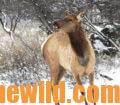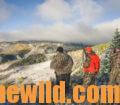Editor’s Note: “Because we harvest 45 – 50 elk every year, and I’ve been guiding elk hunters for 27 years, I’ve probably called in over 800 elk that have been taken at our outfitting company, Fulldraw Outfitters (www.fulldrawoutfitters.com),” Fred Eichler of Aguilar, Colorado, explains. To learn more about Eichler, go to his Facebook page at https://www.facebook.com/pg/fredeichlerpage/.
Another thing I’ve learned about elk hunting is their noses are at least as good as a coyote’s nose. They know where you’ve walked, and they’ll avoid that area. Another thing that I’ve learned is that most people aren’t comfortable hunting from the ground, since the majority of hunters I guide for are great whitetail hunters from the East. They are accustomed to hunting out of tree stands and  ground blinds and are very-effective hunting from these. However, where we hunt elk, we have to hike to locate the elk. Then we have to find a place with cover, so the bull elk can’t see us when he comes in, but we can’t have so much cover that the hunter can’t get a shot, if the bull doesn’t come straight in/or has to turn left or right. When a bowhunter draws his bow, there’s a lot of motion that the elk can spot.
ground blinds and are very-effective hunting from these. However, where we hunt elk, we have to hike to locate the elk. Then we have to find a place with cover, so the bull elk can’t see us when he comes in, but we can’t have so much cover that the hunter can’t get a shot, if the bull doesn’t come straight in/or has to turn left or right. When a bowhunter draws his bow, there’s a lot of motion that the elk can spot.
Something else that elk hunters don’t realize is that as a guide, I have to call 10 elk to within bow range for a hunter to take one. Either the elk will smell us before he reaches or sees us, or my hunter misses the shot when he releases his arrow. I’ve guided in Colorado and New Mexico, and I’ve talked to elk guides in Idaho and Wyoming, and they all agree that’s about the same number of elk they have to call in for a bowhunter to take an elk with a bow. I wrote a book, “Bowhunting Western Big Game,” and put a lot of information in that book about what the odds are for a bowhunter to harvest an elk. You can order this book on Amazon or our web page (https://www.amazon.com/Bowhunting-Western-Big-Game-Preservation/dp/1620872269).
I’ve learned that the best way to successfully hunt an elk is from a tree stand or to build a ground blind out of available brush. I’ve also learned that to be successful taking an elk you need a guide or a hunting buddy calling to the elk about 20 to 30 yards behind the shooter. For the guys hunting by themselves, I tell them if you’re calling, and you know there’s an elk 100-200 yards in front of you, move up 50 yards from the spot you’ve called from, because a bull can pinpoint exactly where you’ve called from, so when he comes in, he’ll slow down and look for the cow. At 50 yards, the bull elk know they either should hear the cow, see her or both.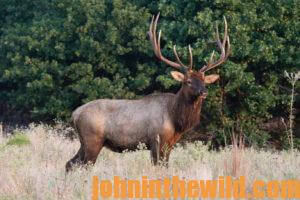
Another thing I do is if I’m guiding or calling, I’ll snap branches and rake a tree with a limb. Even if I’m only cow calling every 20 minutes, I may break sticks during that dead time between the calls I make or move a little bush, just like the turkey hunter often scratches in the leaves when he’s got a gobbler in front of him that won’t come into his calling. When a bull comes in, he’ll stop. If he doesn’t hear a cow elk moving around or doesn’t see what looks like a cow elk, then he quickly assumes no cow elk is there. Once a bull comes in, he’s looking for more than one cow because very rarely do you see a cow elk walking through the woods by herself. A group of elk make a lot of noise, so when I cow call, I’ll use several different elk calls. I’ll not only sound like cows, I want to sound like calves and spike bulls. As I’m mixing up my calls, I’ll also be making noise like a small herd of elk. A lot of times my clients won’t understand why I’m making so much noise, because as whitetail hunters, they want to be as quiet as possible. So, now I tell my clients, once I start calling, “I’ll be walking around, raking bushes and breaking limbs behind you. I haven’t really lost my mind; I’m just trying to sound like a small herd of elk. But don’t get excited, come to full draw, and turn around ready to shoot because all that noise is just me.” Most of the people I hunt with assume that calling elk is j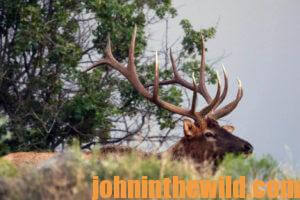 ust making vocalizations that elk make when they talk to each other, but to put realism into your calling, you not only need to talk like a small herd of elk, you have to sound like a small herd moving around in the timber.
ust making vocalizations that elk make when they talk to each other, but to put realism into your calling, you not only need to talk like a small herd of elk, you have to sound like a small herd moving around in the timber.
Yet another misconception that most elk hunters have is they read the information that’s put out by the Game and Fish Division in the state where they’re hunting in and get a misconception of what their realistic chances are for taking an elk. The reason for that is for instance in Colorado, where I live, hunt and guide, the Game and Fish Department says that hunters have about a 13-14% chance of taking an elk when they come out here to hunt. What they are not telling the hunter is that that 14% success rate for an archery hunter includes guided hunts, limited-draw hunts, where just about every hunter tags his elk because some of those areas take 24 years to draw the tag, private-land hunts and public-land hunts. So, if you’re coming out to hunt on public land, you may be thinking you have a 13-14 % chance of taking an elk, but you don’t know from what statistic that percentage comes. If the Game Department would post what percentage of hunters on public lands are successful that weren’t being guided, that percentage might be far less than 13-14%. It might only be 1-2% for bowhunters.
The main reason is that most of the hunters who come from the East and want to do a do-it-yourself hunt don’t realize the difference there is in hunting elk in the West from hunting whitetails in the East. And, they don’t realize that elk act differently than whitetails and move over larger tracts of land than whitetails do. Guided hunts, private-land hunts and limited-entry hunts have much-higher success percentages than do-it-yourself public-land hunts. Too, the terrain is so much different. Wind direction changes sometimes on an hourly basis, and the sun is different out here. A hunter may set-up to try to take an elk and think he’s in the shade, but when the sun comes over the mountain, he’s in full sun, or the sun may be in his eyes instead of the elk’s. I spend quite a bit of time trying to pick the right spot for my hunter to stand and the right place for me to 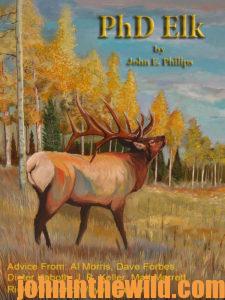
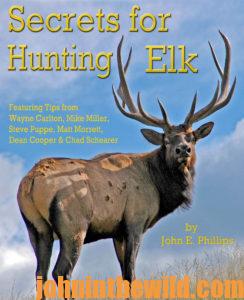 stand and call from where the elk won’t see me. Another common mistake is the hunter will stand in a spot with an elk coming in that’s too open, and the elk will be able to see him before he gets into bow range. Or he’ll get into thick cover where the elk can’t see him, but the hunter can’t get a clear shot because of bushes or branches.
stand and call from where the elk won’t see me. Another common mistake is the hunter will stand in a spot with an elk coming in that’s too open, and the elk will be able to see him before he gets into bow range. Or he’ll get into thick cover where the elk can’t see him, but the hunter can’t get a clear shot because of bushes or branches.
To learn more about elk hunting, check out John E. Phillips’ books, “PhD Elk: How to Hunt the Smartest Elk in Any State” and “Secrets for Hunting Elk,” both available at
http://amzn.to/WkbAWa and http://amzn.to/WGb9le.
Tomorrow: Fred Eichler Explains Why He Started Guiding for Elk

